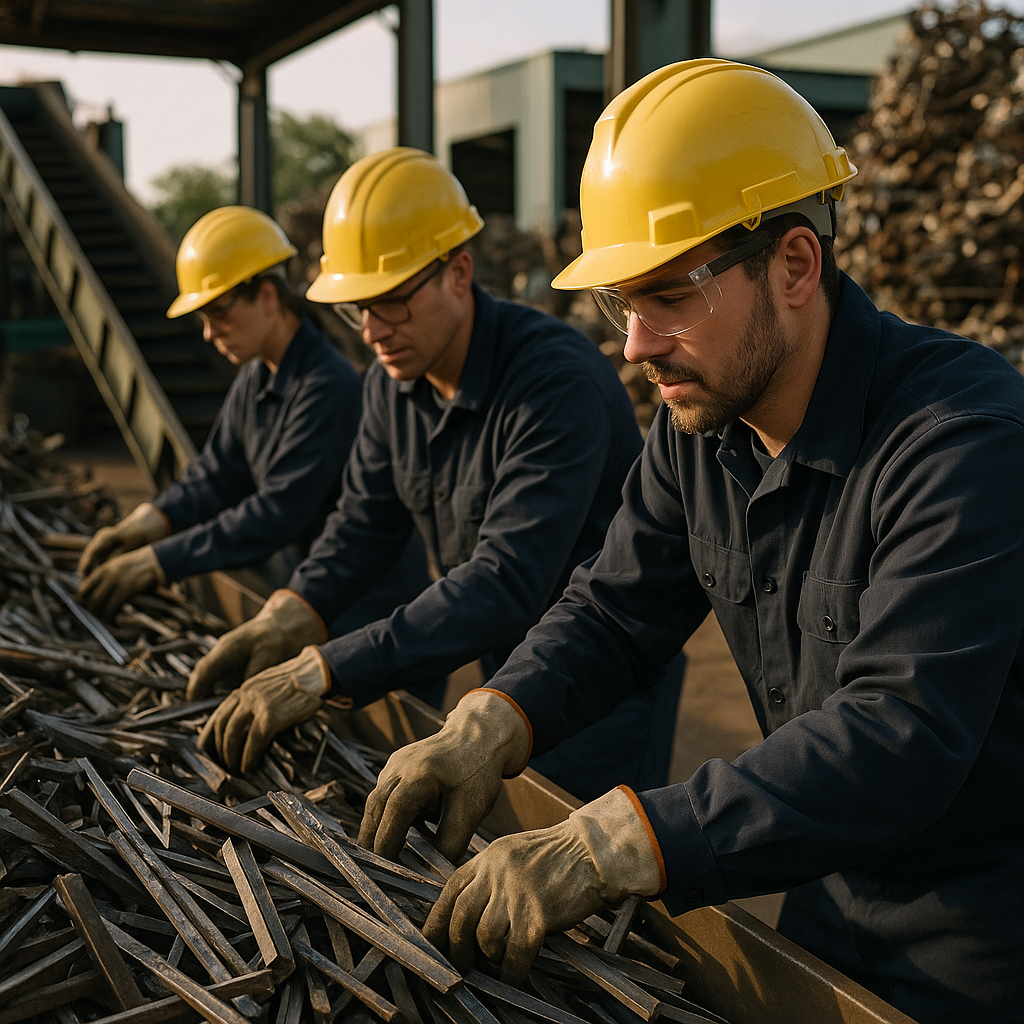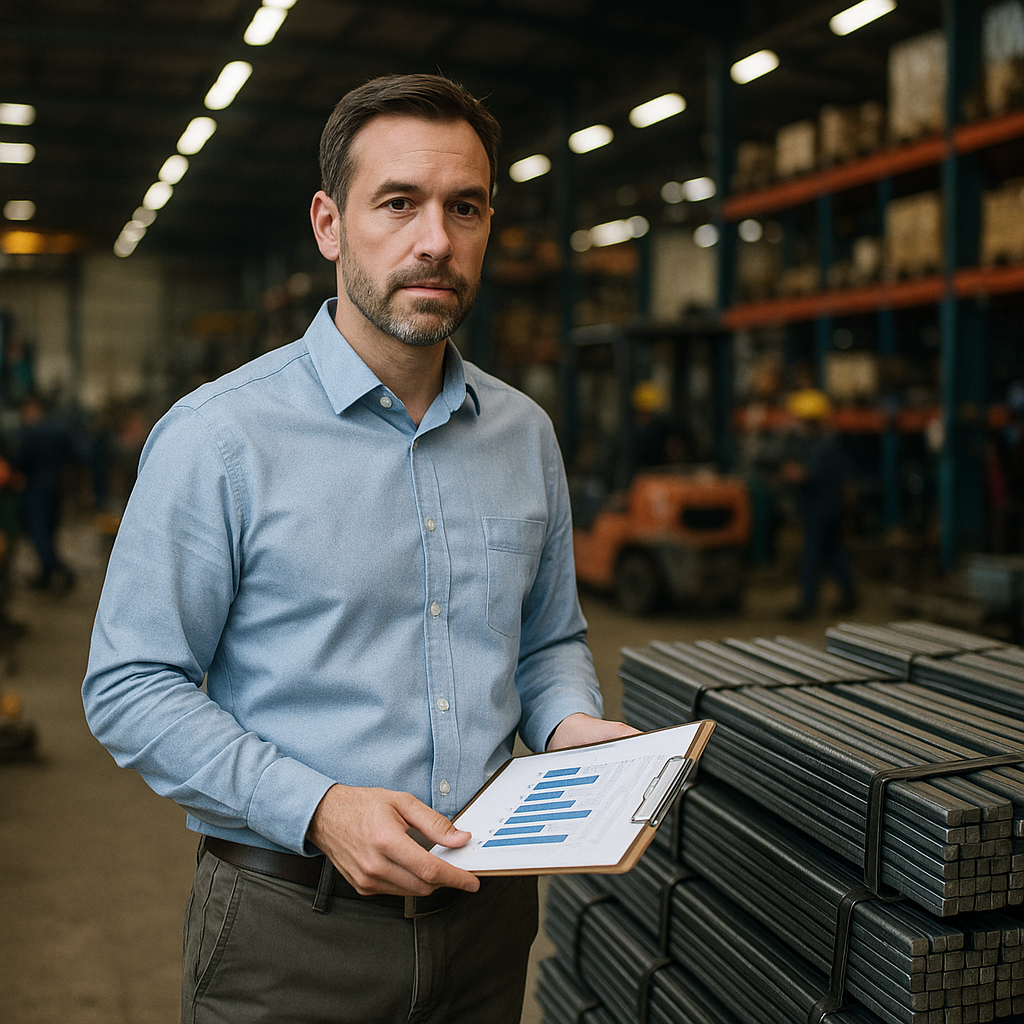5901 Botham Jean Blvd, Dallas, TX 75215
Scrap Steel Recycling: Process, Energy Savings & Economic Impact
September 18, 2025Steel recycling is one of the most impactful sustainability practices in modern waste management systems. Essentially, scrap steel recycling involves collecting, sorting, and transforming used steel materials into new products. This method keeps valuable metal resources in circulation instead of depleting fresh reserves.
The numbers tell a compelling story. Steel is one of the most recycled materials in North America, with over 60% recycled annually since 1970. This high recycling rate is not just impressive; it’s crucial for environmental preservation. Recycling steel reduces the need for extracting raw materials from the earth.
This sustainable practice offers multiple environmental benefits. It conserves natural resources by lowering the demand for iron ore, coal, and limestone. The energy savings are substantial—recycling steel uses 75% less energy than producing it from raw materials. Furthermore, the process generates significantly fewer greenhouse gas emissions, helping combat climate change while keeping useful materials out of landfills.
What Are the Steps in the Steel Recycling Process?

The steel recycling process consists of several methodical stages that transform discarded steel into new, usable products. This efficient system allows steel to be recycled indefinitely without losing its inherent properties. Let’s examine each stage of this process.
1. Collection
The journey begins by gathering scrap steel from diverse sources, including old vehicles, demolished buildings, discarded appliances, and industrial equipment. Scrap yards, recycling centers, and dedicated collection points play crucial roles in accumulating these materials.
Collection bins at businesses and homes help separate steel from other waste streams. Some recycling facilities offer transportation services for large industrial quantities of scrap steel, making the process more accessible for businesses with substantial volumes.
2. Sorting and Separation
Once collected, the steel undergoes thorough sorting to ensure quality recycling outcomes. Workers and automated systems separate ferrous metals (containing iron) from non-ferrous metals using powerful magnets. This magnetic separation is highly effective since steel contains iron.
The sorting process also removes non-metallic materials like plastic, rubber, and other contaminants. Advanced facilities employ infrared scanning and x-ray technology to identify different metal types and assess their purity levels. This precise sorting creates cleaner material streams for subsequent processing.
3. Processing and Compacting
The sorted steel is compacted and squeezed to reduce volume and prepare it for further processing. Hydraulic machinery applies tremendous pressure to compress the materials, maximizing transportation efficiency and preparing the metal for the cutting phase.
Large industrial balers and compactors transform loose scrap into dense, manageable bundles. These machines can exert thousands of pounds of pressure to create compact steel packages that take up significantly less space.
4. Shredding
Next, the compacted steel is moved to shredders that cut it into smaller, uniform pieces. Powerful hammer mills break down the material into fragments with increased surface area. This size reduction is crucial for the melting stage.
The shredding process creates pieces with optimal dimensions for efficient melting. Smaller fragments heat more quickly and uniformly, reducing energy requirements in the furnace. Some advanced facilities can process several tons of steel per hour through their shredding operations.
5. Melting
The shredded steel enters large furnaces where temperatures reach nearly 3,000 degrees Fahrenheit. Different types of furnaces serve various purposes in the industry. Electric arc furnaces are commonly used for recycled steel because they consume less energy than traditional blast furnaces.
The melting process transforms solid steel fragments into molten metal. This phase consumes significant energy but requires 74% less energy than producing new steel from raw iron ore. The duration of melting depends on the volume and type of steel being processed.
6. Purification
During melting, impurities rise to the surface and are removed. Techniques such as electrolysis help separate the pure metal from contaminants. This purification step ensures the recycled steel meets quality standards for manufacturing applications.
Some facilities use additional chemical processes to extract specific impurities. The goal is to create a pure metal product that maintains the desirable properties of steel. The removed impurities are typically collected as slag and often recycled for other applications like road construction.
7. Solidification
After purification, the molten steel moves through a cooling chamber where it solidifies into new forms. Some steel is formed into sheets, while other batches become solid blocks or ingots. These standardized shapes facilitate easy transportation and use by manufacturers.
The solidification process often includes the addition of specific elements to create steel alloys with desired characteristics. The cooling rate is carefully controlled to achieve specific structural properties in the final product.
8. Transportation to Manufacturers
The final stage involves transporting the processed steel to manufacturers who will transform it into new products. From construction beams to automotive parts, the recycled steel begins its new life cycle. The steel can be recycled repeatedly without degrading in quality.
This closed-loop system creates significant environmental benefits by reducing the need for raw material extraction. It also decreases energy consumption and greenhouse gas emissions compared to producing new steel from iron ore.
The efficient steel recycling process demonstrates how valuable materials can be continuously recirculated in our economy. This system conserves natural resources while maintaining the supply of this essential building material for countless applications.
What Are the Environmental Benefits of Recycling Steel?

Recycling steel offers substantial environmental benefits beyond waste reduction. Conserving natural resources is among the most significant advantages. Each ton of recycled steel saves approximately 2,500 pounds of iron ore, 1,400 pounds of coal, and 120 pounds of limestone. This preservation helps protect finite raw materials that would otherwise require extensive mining and extraction.
The energy savings from steel recycling are equally notable, requiring up to 75% less energy than producing steel from virgin materials. This translates to about 16-19 gigajoules saved per ton of steel produced, reducing strain on power grids and lessening the dependence on fossil fuels.
Reducing carbon emissions is another critical environmental benefit. Recycling steel generates 70-80% fewer CO2 emissions than conventional manufacturing. Every ton of steel recycled instead of produced from raw materials prevents roughly 1.5 tons of carbon dioxide emissions, significantly contributing to global climate change mitigation efforts.
The reduction in mining impact is another essential advantage of steel recycling. Traditional iron ore extraction disrupts land, destroys habitats, and pollutes water. By recycling steel, the need for these harmful mining operations is minimized. Every ton of recycled steel negates the extraction of approximately 1.6 tons of ore and associated overburden.
Water conservation is also a notable aspect of steel recycling’s environmental profile. Producing recycled steel requires 40-50% less water than primary production methods, saving about 50-60 cubic meters of water per ton—critical in areas facing water scarcity.
Reducing landfill waste is another important benefit. Metal waste in landfills can contaminate soil and groundwater. By recycling steel, we prevent these issues and preserve valuable landfill space. Each ton of recycled steel prevents about 2 tons of waste from entering landfills.
The cumulative effect of these environmental benefits highlights why steel recycling is a cornerstone of sustainable waste management. Since steel is infinitely recyclable without losing its essential properties, these advantages can continue indefinitely as we advance towards a more circular economy.
What Are the Economic Advantages of Steel Recycling?

Steel recycling offers substantial economic benefits at multiple levels of the U.S. economy. The industry generates jobs, reduces production costs, and significantly contributes to national economic growth and stability.
Job creation is a major economic advantage of steel recycling. The recycling process drives employment across the entire value chain. According to the American Iron and Steel Institute, the scrap recycling industry produces over 531,000 jobs across the United States. This includes positions in collection, processing, transportation, and manufacturing sectors.
These jobs provide stable incomes for American families and generate substantial tax revenue. The U.S. scrap industry contributes more than $10 billion annually in federal and state taxes, supporting essential public services and infrastructure projects.
For businesses, steel recycling offers clear financial advantages. Manufacturing with recycled materials greatly reduces production costs compared to using virgin resources. Traditional steel production requires mining raw ore, transporting it to processing facilities, and energy-intensive refining. Recycling eliminates these costly steps.
Recycled steel is often more affordable than newly produced metal. Recent market data shows recycled steel costs approximately $415 per ton, while virgin steel can reach $920 per ton. This price difference of about $505 per ton creates substantial savings for manufacturers and construction companies.
The economic impact extends to individuals and organizations that generate steel waste. Scrap yards pay competitive rates for collected steel, providing financial incentives that help offset disposal costs. This creates a win-win situation where environmentally responsible behavior also delivers economic benefits.
At the macroeconomic level, the steel recycling industry drives substantial economic activity. The Institute of Scrap Recycling Industries (ISRI) reports that the U.S. metal recycling industry generated over $64 billion in 2020 alone. This economic contribution supports local economies, promotes international trade, and strengthens the nation’s manufacturing base.
The industry also provides valuable market stability. By supplying a consistent stream of recycled materials, steel recycling helps buffer against price volatility in raw material markets. This stability benefits manufacturing industries that rely on predictable supply chains and pricing structures.
Steel recycling’s economic benefits are especially notable considering the material’s infinite recyclability. Unlike other resources that degrade with repeated recycling, steel maintains its quality and value through unlimited cycling. This creates a sustainable economic model that continues to deliver benefits over time.
Conclusion: The Future of Scrap Steel Recycling
Scrap steel recycling is a key player in both environmental stewardship and economic growth. The industry’s dedication to sustainability has turned what was once waste into a valuable resource, conserving natural materials, reducing energy consumption, and cutting greenhouse gas emissions. Each ton of recycled steel saves approximately 2,500 pounds of iron ore, 1,400 pounds of coal, and 120 pounds of limestone from being extracted.
The future of scrap steel recycling appears promising as technological innovations continue to reshape the industry. AI-powered sorting systems, blockchain technology for supply chain transparency, and advanced material recovery facilities are enhancing the efficiency of recycling processes. These technologies allow for the recovery of materials as small as 0.2mm, minimizing waste and maximizing resource utilization to support a truly circular economy.
For your metal recycling needs and to join the movement toward a more sustainable future, contact Okon Recycling at 214-717-4083.
